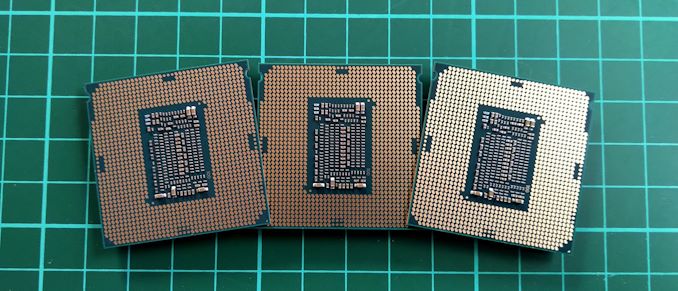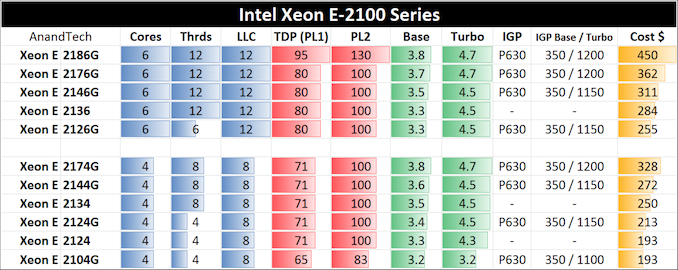The Xeon Entry Quad-Core CPU Review: Xeon E-2174G, E-2134, and E-2104G Tested
by Ian Cutress on March 11, 2019 10:30 AM EST- Posted in
- CPUs
- Xeon
- Enterprise CPUs
- Coffee Lake
- Xeon E
- C246
Quad Core Xeon-E Conclusion
In this review, we focused on the results from our quad core Xeon E testing. These processors form part of Intel's portfolio that caters to small and medium businesses that want managed office systems with reasonable performance, or for entry level SOHO servers or storage platforms. In this market, Intel is competing against AMD's Ryzen Pro line of CPUs.
The processors we tested for this review are Intel's first generation of Xeon Entry chips, which would have been the E3-1200 v7 family if it were not for the recent name change across Intel's processor lines. This hardware is based on Intel's Coffee Lake microarchitecture, the latest generation of Intel's 14nm family of processors, and Intel offers a variety of quad and six core parts, some with integrated graphics and some without.
By and large, we weren't expecting to see anything crazily radical with the E-2174G, the E-2134, and the E-2104G that we tested for this review. The results are run of the mill, and the E-2174G sits at the top of the other quad cores in all tests as we expected it to.
The E-2104G is perhaps the odd one out here, as it doesn't form part of Intel's regular Xeon E product family. This processor is classified as 'off-roadmap', which means it wasn't part of Intel's original plan and it was built for specific customers with requests for specific performance levels or to hit a certain price point. These chips rarely find their way to retail, and being the lowest processor of the Xeon E quad core line, it certainly performs as such.
Users who need Xeon E parts are typically looking for prebuilt machines with mainstream levels of performance but have requirements for manageability and/or ECC memory. Without any of those requirements, Intel's consumer processor line offers more system performance and higher specs for the same system price. AMD's Ryzen Pro line are an alternative to Xeon E, offering manageability through the DASH interface, and scale from quad core to eight core. If we can get samples of the Ryzen Pro linen we'll test them as well to see how they stand up to Intel.
For users interested in the future of this processor line, that's a hard one to answer. We've seen hints that Intel might launch eight core versions of Xeon E, although we expected those in the market last year and they haven't materialised. We expect Intel to move to 10nm for its next gen processor line, however the earliest those will be ready seems to be 2020, and the mainstream Xeon E processors typically come out six to nine months after the consumer versions do, so we might be looking at the end of 2020 before the next generation of Xeon E are released (unless Intel surprises us in late 2019 with another generation on 14nm)
 |
We also reviewed the Xeon Entry six-core processors: Intel Xeon E Six-Core Review: |












29 Comments
View All Comments
mode_13h - Monday, March 11, 2019 - link
Those interested in ECC-support should also consider Intel's Core i3 CPUs. Most of those also support ECC. Do check their site, to be certain:https://ark.intel.com/content/www/us/en/ark/search...
mode_13h - Monday, March 11, 2019 - link
Also, it should go without saying that you need to pair it with a motherboard with ECC support.mode_13h - Monday, March 11, 2019 - link
For instance, compare the E-2174G with the i3-8350K:https://ark.intel.com/content/www/us/en/ark/compar...
eastcoast_pete - Monday, March 11, 2019 - link
Thanks Ian! While I know that my following suggestion might be overly simple, I like to also look at the value for money, especially for business tech like that. To do so, I simply divide the benchmarks by the price, resulting in performance/$ . If nothing else, it makes it easier to compare hardware that is at least within a certain range. Doing that, the Ryzen 2600 is the overall price/performance champion, whereas the Xeon 2146G is the likely choice if more speed and other features become important. I don't see much upside in the premium four core (2174G) over the (cheaper and usually faster ) six core 2146G.eastcoast_pete - Monday, March 11, 2019 - link
This didn't make it into my comment:Question @Ian: I saw you mention the performance /price once in your article, but is there a way to show that" Bang for the Buck" in a summary graph? I believe it might help put things into perspective, especially when comparing CPUs or GPUs where the most expensive costs 2-3 times as much as the cheapest.
msroadkill612 - Tuesday, March 12, 2019 - link
The 2600 is on sale for 7 days at newegg for $165, but it seems the going regular price for it atm.msroadkill612 - Tuesday, March 12, 2019 - link
TLDR,but buyers should also consider cooling and mobo relative costs also. afaik, many, if not all intels have no cooler, whereas tha amd included ones are regarded as qyute decent if not overclocking.peevee - Tuesday, March 19, 2019 - link
What a terrible mess the whole Intel lineup is.bimuzubi - Sunday, December 8, 2019 - link
Definitely, but here the power envelope is important for the test, which Anandtech doesn't seem to give. It's quite worrisome how most of those Xeons are operating outside of their power envelope, that E-2174G that you are referring to is pulling 85W for a rated 71W, so Intel gives a P2 power limit. Why bother with the normal TDP then? The 2600 seems to be owning price/performance and TDP/performance. Question there is EEC memory support, and the guarantee/testing including with Xeons https://adultpornroll.com/category/asian-porn-tube... . That's why I mentioned including TR in the benchmarks, or at least the 2700X.